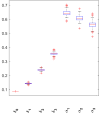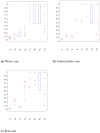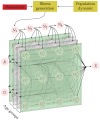Mathematical Modeling for the Assessment of Public Policies in the Cancer Health-Care System Implemented for the Colombian Case
- PMID: 37754600
- PMCID: PMC10531264
- DOI: 10.3390/ijerph20186740
Mathematical Modeling for the Assessment of Public Policies in the Cancer Health-Care System Implemented for the Colombian Case
Abstract
The incidence of cancer has been constantly growing worldwide, placing pressure on health systems and increasing the costs associated with the treatment of cancer. In particular, low- and middle-income countries are expected to face serious challenges related to caring for the majority of the world's new cancer cases in the next 10 years. In this study, we propose a mathematical model that allows for the simulation of different strategies focused on public policies by combining spending and epidemiological indicators. In this way, strategies aimed at efficient spending management with better epidemiological indicators can be determined. For validation and calibration of the model, we use data from Colombia-which, according to the World Bank, is an upper-middle-income country. The results of the simulations using the proposed model, calibrated and validated for Colombia, indicate that the most effective strategy for reducing mortality and financial burden consists of a combination of early detection and greater efficiency of treatment in the early stages of cancer. This approach is found to present a 38% reduction in mortality rate and a 20% reduction in costs (% GDP) when compared to the baseline scenario. Hence, Colombia should prioritize comprehensive care models that focus on patient-centered care, prevention, and early detection.
Keywords: cancer care; discrete time; health system; identifiability analysis; mathematical modeling; parameter estimation; public health; public policies; sensitivity analyses.
Conflict of interest statement
The authors declare no conflict of interest.
Figures













Similar articles
-
Fine-grained mathematical modeling for cost-effectiveness evaluation of public health policies for cervical cancer, with application to a Colombian case study.BMC Public Health. 2023 Aug 2;23(1):1470. doi: 10.1186/s12889-023-16022-x. BMC Public Health. 2023. PMID: 37533028 Free PMC article.
-
The effectiveness of web-based programs on the reduction of childhood obesity in school-aged children: A systematic review.JBI Libr Syst Rev. 2012;10(42 Suppl):1-14. doi: 10.11124/jbisrir-2012-248. JBI Libr Syst Rev. 2012. PMID: 27820152
-
Use of the six core surgical indicators from the Lancet Commission on Global Surgery in Colombia: a situational analysis.Lancet Glob Health. 2020 May;8(5):e699-e710. doi: 10.1016/S2214-109X(20)30090-5. Lancet Glob Health. 2020. PMID: 32353317
-
Conquering the intolerable burden of malaria: what's new, what's needed: a summary.Am J Trop Med Hyg. 2004 Aug;71(2 Suppl):1-15. Am J Trop Med Hyg. 2004. PMID: 15331814 Review.
-
Incorporating social determinants of health into the mathematical modeling of HIV/AIDS.Sci Rep. 2022 Nov 29;12(1):20541. doi: 10.1038/s41598-022-24459-0. Sci Rep. 2022. PMID: 36446878 Free PMC article. Review.
References
Grants and funding
LinkOut - more resources
Full Text Sources

